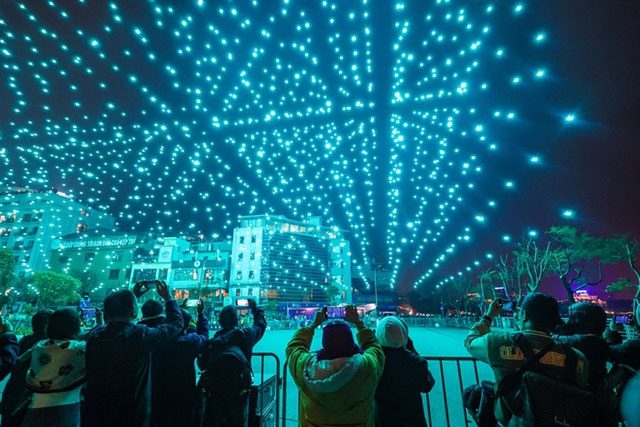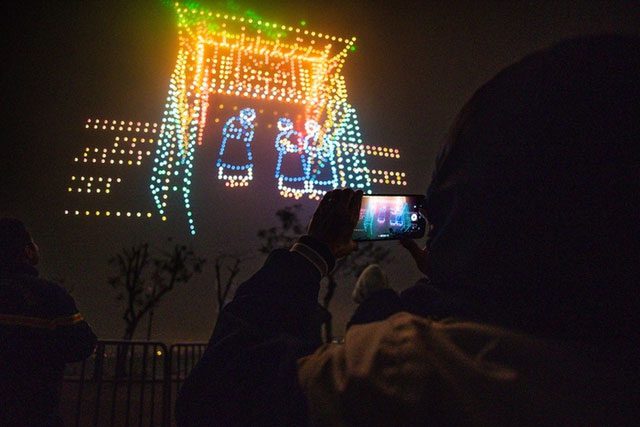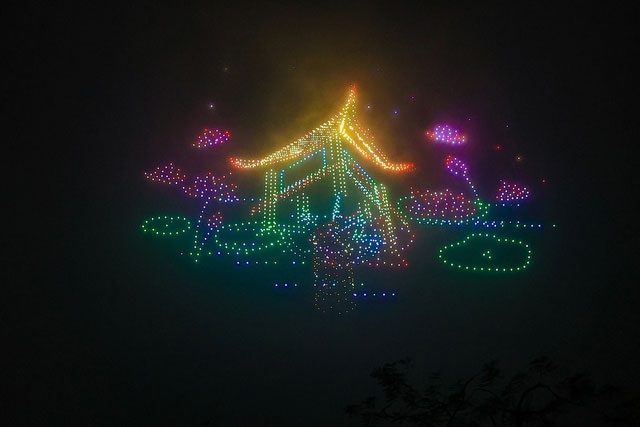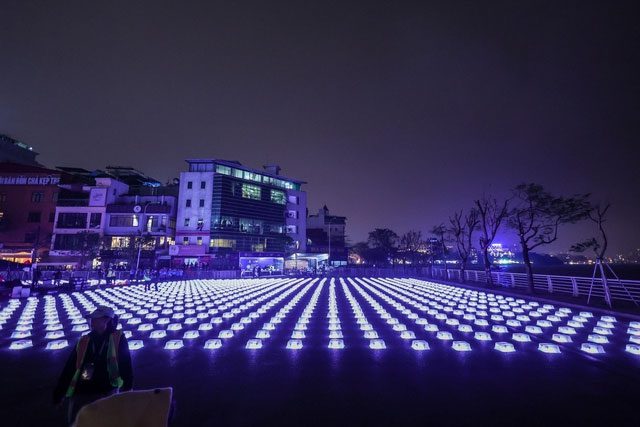On the evening of February 9th in Hanoi, the performance of the “Hanoi Art Light Festival – Brilliant Thang Long” took place, featuring over 2,000 drones flying together to create stunning light displays in the sky, captivating the attention and admiration of thousands of residents in the capital.
The drones were arranged to form various iconic images of Hanoi and Vietnamese culture, such as the depiction of the “Chiếu dời đô,” commemorating the decision of King Lý Thái Tổ to move the capital from Hoa Lư to Đại La (present-day Hanoi) in 1010, images of dragons from the Lý dynasty representing the spirit and aspirations of the nation, as well as the images of the Thang Long Imperial Citadel, Trấn Quốc Pagoda, Hoan Kiem Lake, and One Pillar Pagoda.
This event marks a significant milestone in the use of drone technology for artistic purposes in Vietnam. It also represents a completely new form of artistic performance that has only emerged globally in recent years.

Photo: Lê Minh Sơn

Residents eagerly watch the performance of the “Hanoi Art Light Festival – Brilliant Thang Long.” (Photo: Lê Minh Sơn).
Previously, in 2012 in Linz (Austria), the world witnessed a special event that opened a new era for light art: a drone performance organized by Ars Electronica Futurelab.
With the introduction of the concept of “SPAXELS” (spatial pixels), this event marked a crucial turning point, transforming drones from simple flying devices into “artists” in the night sky, offering audiences impressive light art experiences. The drones, typically quadcopters, equipped with multicolored LED lights and high maneuverability, performed evening displays.

The One Pillar Pagoda vividly recreated. (Photo: Lê Minh Sơn).
Subsequently, Intel, with its Shooting Star drone product, contributed to elevating drone performances to new heights. These drones have been used in many major international events, including the 2018 Winter Olympics, halftime shows at Super Bowl 2017, and the Independence Day celebration on July 4, 2018, in the United States, showcasing the immense capability and potential of drone technology in entertainment and advertising.
Drone performances offer significant advantages over traditional fireworks due to their lack of air pollution and noise, as well as their reusability. Since 2020, several cities in the U.S. have begun replacing firework displays with drones or lasers on Independence Day to reduce fire risks, air pollution, and lessen negative impacts on the environment and public health. However, organizing these performances also faces limitations as they cannot occur during adverse weather conditions such as heavy rain or strong winds.
How are drone art performances staged?
In a drone art performance, the operation and control methods are the essence of each mesmerizing light display in the sky. Typically, a team of skilled engineers and creative designers is responsible for organizing such shows.
First, a central control system is usually utilized to coordinate and synchronize the activities of hundreds, even thousands, of drones simultaneously. Signals (via radio waves) are transmitted from this system to each drone, ensuring they operate according to a precise and consistent script.

The type of drone used for the performance has excellent flying capabilities.
Next, planning and designing the flight maneuvers of the drones are carried out using specialized software such as Drone Show Software or Skybrush Suite, allowing the organizers to simulate and control synchronized movements and light effects. Each drone in the formation is programmed with a specific flight path, creating unique images in the sky, ranging from simple shapes to complex designs like company logos or symbolic images.

The interface of the specialized Drone Show Software, allowing organizers to simulate and control synchronized movements and light effects of the drones.
The uniqueness of the flying drones in the performance lies in their diverse shapes, flexibility, and high accuracy. To achieve this, drones are equipped with advanced technologies such as GPS and various sensors, enabling them to determine their position and adjust altitude, speed, and flight direction accurately. In case of emergencies, drones are also equipped with safety mechanisms to ensure maximum safety and allow for controlled landings if necessary. As a result, the performances are not only safe but also visually stunning, providing a unique experience for viewers.

The choice of location for the performance is a critical factor determining the success of the show. (Photo: Lê Minh Sơn).
During the preparation and execution of a drone light performance, the selection of the venue is also a key factor determining the success of the performance. The location must be carefully chosen to ensure not only safety but also the ability to create an impressive and uninterrupted experience for the audience.
The area and characteristics of the performance venue must be sufficiently large and appropriate to meet the needs of the drone formation, from ensuring free flight space to providing a clear view for the audience. Prior to the flight, meticulous checks are carried out using various tools to ensure that all drones are operational, with fully charged batteries and favorable weather conditions.


















































